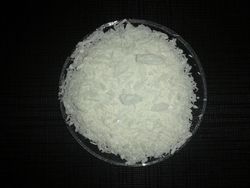Difference between revisions of "Tin(II) chloride"
| Line 179: | Line 179: | ||
[[Category:Materials unstable in basic solution]] | [[Category:Materials unstable in basic solution]] | ||
[[Category:Materials that react with water]] | [[Category:Materials that react with water]] | ||
| + | [[Category:Irritants]] | ||
Revision as of 16:04, 6 July 2017
 Crystals of SnCl2·2 H2O on a watchglass.
| |
| Names | |
|---|---|
| IUPAC names
Tin(II) chloride
Tin dichloride | |
| Systematic IUPAC name
Tin(II) chloride | |
| Other names
Stannous chloride
Tin salt Tin protochloride | |
| Identifiers | |
| Jmol-3D images | Image |
| |
| Properties | |
| SnCl2 | |
| Molar mass | 189.60 g/mol (anhydrous) 225.63 g/mol (dihydrate) |
| Appearance | White crystalline solid |
| Odor | Odorless |
| Density | 3.95 g/cm3 (anhydrous) 2.71 g/cm3 (dihydrate) |
| Melting point | 247 °C (477 °F; 520 K) (anhydrous) 37.7 °C (dihydrate) |
| Boiling point | 623 °C (1,153 °F; 896 K) (decomposes) |
| 83.9 g/100 ml (0 °C) Hydrolyses in hot water | |
| Solubility | Soluble in acetone, diethyl ether, ethanol, hydrochloric acid, tetrahydrofuran Insoluble in ethyl acetate, toluene, xylene |
| Hazards | |
| Safety data sheet | AcrosOrganics (anhydrous) LabChem (dihydrate) |
| Lethal dose or concentration (LD, LC): | |
| LD50 (Median dose)
|
700 mg/kg (rat, oral) 10,000 mg/kg (rabbit, oral) 250 mg/kg (mouse, oral) |
| Related compounds | |
| Related compounds
|
Tin(IV) chloride |
| Except where otherwise noted, data are given for materials in their standard state (at 25 °C [77 °F], 100 kPa). | |
| Infobox references | |
Tin(II) chloride, also known as stannous chloride, is a white crystalline solid with the formula SnCl2. It has many uses, most notably in the tin-plating of steel, as well as many uses in organic chemistry, as catalyst and reducing agent.
Contents
Properties
Chemical
Stannous chloride forms a stable dihydrate salt when dry, but aqueous solutions tend to undergo hydrolysis, particularly if hot.
- SnCl2 (aq) + H2O (l) ⇌ Sn(OH)Cl (s) + HCl (aq)
Because of this inconvenience, tin(II) chloride solutions tend to be made with dilute hydrochloric acid, rather than neutral water.
Solutions of SnCl2 are also unstable if kept in air:
- 6 SnCl2 (aq) + O2 (g) + 2 H2O (l) → 2 SnCl4 (aq) + 4 Sn(OH)Cl (s)
If a base, like sodium hydroxide is added to a solution of SnCl2, a white precipitate of hydrated tin(II) oxide forms initially, which dissolves in excess base to form a stannite salt, such as sodium stannite:
- SnCl2(aq) + 2 NaOH (aq) → SnO·H2O (s) + 2 NaCl (aq)
- SnO·H2O (s) + NaOH (aq) → NaSn(OH)3 (aq)
Tin(II) chloride is also a reducing agent, capable of reducing silver ions to silver metal:
- Sn2+ (aq) + 2 Ag+ → Sn4+ (aq) + 2 Ag (s)
This process is used for silvering mirrors, where silver metal is deposited on glass.
In organic chemistry, SnCl2 is generally used as a reducing agent, like in the Stephen reduction, where a nitrile group is reduced (via an imidoyl chloride salt) to an imine which is easily hydrolyzed to an aldehyde. It can also be used to selectively reduce aromatic nitro groups to anilines.
Physical
Tin(II) chloride is an odorless, white crystalline solid compound. It is soluble in water, and can dissolve in less than its own mass of water without apparent decomposition. It is also soluble in other solvents such as ethanol, acetone and ethers, but it is insoluble in non-polar solvents like xylene.
Availability
Tin(II) chloride is sold by various chemical suppliers.
Preparation
Tin(II) chloride dihydrate can be made by dissolving tin in concentrated hydrochloric acid. Lead-free solder can be used. The dihydrate crystals are obtained by cooling the solution in an excess hydrochloric acid.
Anhydrous SnCl2 can be made by passing dry hydrogen chloride gas over tin metal. The reaction must be performed in a very dry environment.
Projects
- Silver mirrors
- Test for silver and other precious metals in the electronic recycling recovery
- Reduce aromatic nitro groups to anilines
- Tin(IV) chloride synthesis
Handling
Safety
Tin(II) chloride is toxic if ingested and solutions contain hydrochloric acid which is corrosive.
Storage
Tin(II) chloride dihydrate should be stored in glass or plastic containers, away from any moisture.
Anhydrous tin(II) chloride should be stored in sealed containers, away from air and moisture.
Disposal
Tin(II) chloride should be converted to tin oxide and taken to waste disposal centers or recycled.
References
Relevant Sciencemadness threads
- Chemical pages without CAS Registry Number
- Articles without EBI source
- Chemical pages without ChemSpiderID
- Chemical pages without DrugBank identifier
- Articles without KEGG source
- Articles without InChI source
- Articles without UNII source
- Articles containing unverified chemical infoboxes
- Chemical compounds
- Inorganic compounds
- Tin compounds
- Chlorides
- Lewis acids
- Materials unstable in basic solution
- Materials that react with water
- Irritants